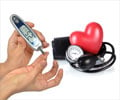A new study has shown that the combination of Lisofylline (LSF), a drug that is being developed to halt immune damage to insulin producing cells, and Islet Neogenesis Associated Protein
Using a combination of a drug called Lisofylline (LSF) and Islet Neogenesis Associated Protein peptide (INGAP) may hold the key to reversing Type I diabetes, a new study has found. LSF is being developed to halt immune damage to insulin producing cells, while INGAP is a protein found in pancreas.
The study was conducted at the University of Virginia by a team of scientists led by Jerry L. Nadler, M.D.Diabetes is caused by the body's inability to produce or process insulin, a hormone that cells need to convert food into energy. Uncontrolled diabetes causes serious complications throughout the body, including cardiovascular disease, blindness, kidney failure, and nerve disease.
Type 1 diabetes is an autoimmune disease, caused when the body's own immune system mistakenly attacks and destroys the insulin-producing cells of the pancreas. This damage was once thought to be irreversible, however, new evidence suggests that the pancreas has an innate ability to repair and regenerate the insulin-producing cells. In Type 1 diabetes, however, the pancreas' ability to self-repair cannot keep pace against the autoimmune response that is causing the diabetes.
In this study, diabetic mice were either given a placebo (saline) or treated with LSF, INGAP peptide, or LSF and INGAP together. The remission rate was most striking when mice were first treated with LSF in an effort to dampen the autoimmune system and then treated with the combination of LSF and INGAP peptide.
This novel therapy resulted in a remission of diabetes in 70pc of the mice after all treatments were withdrawn, including animals with very high blood glucose levels prior to treatment.
Mice treated with INGAP peptide alone or INGAP peptide/LSF combinations averaged markedly higher levels of serum insulin after treatment than saline treated controls and were similar to non-diabetic mice. It was only when the combination of LSF and INGAP was used that a reversal of hyperglycemia was observed.
Advertisement
"Our ultimate goal is to improve the health of individuals by discovering novel approaches to the kinds of diseases that take a serious toll on the quality of life in our community and around the world," said Gerald J. Pepe, Ph.D., Dean and Provost of Eastern Virginia Medical School.
Advertisement
The study will be presented at the American Diabetes Association's 68th Annual Scientific Session in San Francisco.
Source-ANI
RAS/L











